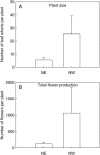Ecological context of breeding system variation: sex, size and pollination in a (predominantly) gynodioecious shrub
- PMID: 17933844
- PMCID: PMC2759233
- DOI: 10.1093/aob/mcm254
Ecological context of breeding system variation: sex, size and pollination in a (predominantly) gynodioecious shrub
Abstract
Background and aims: Species that exhibit among-population variation in breeding system are particularly suitable to study the importance of the ecological context for the stability and evolution of gender polymorphism. Geographical variation in breeding system and sex ratio of Daphne laureola (Thymelaeaceae) was examined and their association with environmental conditions, plant and floral display sizes, and pollination environment in a broad geographic scale was analysed.
Methods: The proportion of female and hermaphrodite individuals in 38 populations within the Iberian Peninsula was scored. Average local temperature and precipitation from these sites were obtained from interpolation models based on 30 years of data. Pollination success was estimated as stigmatic pollen loads, pollen tubes per ovule and the proportion of unfertilized flowers per individual in a sub-set of hermaphroditic and gynodioecious populations.
Key results: Daphne laureola is predominantly gynodioecious, but hermaphroditic populations were found in northeastern and southwestern regions, characterized by higher temperatures and lower annual precipitation. In the gynodioecious populations, female plants were larger and bore more flowers than hermaphrodites. However, due to their lower pollination success, females did not consistently produce more seeds than hermaphrodites, which tends to negate a seed production advantage in D. laureola females. In the northeastern hermaphroditic populations, plants were smaller and produced 9-13 times fewer flowers than in the other Iberian regions, and thus presumably had a lower level of geitonogamous self-fertilization. However, in a few southern populations hermaphroditism was not associated with small plant size and low flower production.
Conclusions: The findings highlight that different mechanisms, including abiotic conditions and pollinator service, may account for breeding system variation within a species' distribution range and also suggest that geitonogamy may affect plant breeding system evolution.
Figures





Similar articles
-
To be or not to be better pollinated: Differences between sex morphs in marginal gynodioecious populations.Am J Bot. 2016 Mar;103(3):388-95. doi: 10.3732/ajb.1500167. Epub 2016 Feb 29. Am J Bot. 2016. PMID: 26928007
-
Male-biased hermaphrodites in a gynodioecious shrub, Daphne jezoensis.Plant Biol (Stuttg). 2016 Sep;18(5):859-67. doi: 10.1111/plb.12463. Epub 2016 May 4. Plant Biol (Stuttg). 2016. PMID: 27090773
-
Sex-specific phenotypic selection and geographic variation in gender divergence in a gynodioecious shrub.Plant Biol (Stuttg). 2015 Jan;17(1):186-93. doi: 10.1111/plb.12192. Epub 2014 May 19. Plant Biol (Stuttg). 2015. PMID: 24841933
-
Gynodioecy to dioecy: are we there yet?Ann Bot. 2012 Feb;109(3):531-43. doi: 10.1093/aob/mcr170. Epub 2011 Aug 1. Ann Bot. 2012. PMID: 21807691 Free PMC article. Review.
-
The thermal ecology of flowers.Ann Bot. 2019 Oct 18;124(3):343-353. doi: 10.1093/aob/mcz073. Ann Bot. 2019. PMID: 31206146 Free PMC article. Review.
Cited by
-
Gender plasticity and sexual system stability in Wurmbea.Ann Bot. 2012 Feb;109(3):521-30. doi: 10.1093/aob/mcr163. Epub 2011 Aug 10. Ann Bot. 2012. PMID: 21831858 Free PMC article.
-
How much better are females? The occurrence of female advantage, its proximal causes and its variation within and among gynodioecious species.Ann Bot. 2012 Feb;109(3):505-19. doi: 10.1093/aob/mcr062. Epub 2011 Mar 31. Ann Bot. 2012. PMID: 21459860 Free PMC article. Review.
-
Floral and mating system divergence in secondary sympatry: testing an alternative hypothesis to reinforcement in Clarkia.Ann Bot. 2014 Jan;113(2):223-35. doi: 10.1093/aob/mct218. Epub 2013 Sep 29. Ann Bot. 2014. PMID: 24081279 Free PMC article.
-
Interaction frequency and per-interaction effects as predictors of total effects in plant-pollinator mutualisms: a case study with the self-incompatible herb Linaria lilacina.Oecologia. 2012 Jan;168(1):153-65. doi: 10.1007/s00442-011-2084-z. Epub 2011 Jul 26. Oecologia. 2012. PMID: 21789530
-
Variation of pollinator assemblages and pollen limitation in a locally specialized system: the oil-producing Nierembergia linariifolia (Solanaceae).Ann Bot. 2008 Nov;102(5):723-34. doi: 10.1093/aob/mcn154. Epub 2008 Sep 2. Ann Bot. 2008. PMID: 18765440 Free PMC article.
References
-
- Alonso C. Pollination success across an elevation and sex ratio gradient in gynodioecious. Daphne laureola. American Journal of Botany. 2005;92:1264–1269. - PubMed
-
- Alonso C, Herrera CM. Neither vegetative nor reproductive advantages account for high frequency of male-steriles in southern Spanish gynodioecious. Daphne laureola. American Journal of Botany. 2001;88:1016–1024. - PubMed
-
- Alonso C, Pérez R, Nieto PM, Delgado J. Gender dimorphism and altitudinal variation of secondary compounds in leaves of the gynodioecious shrub. Daphne laureola. Journal of Chemical Ecology. 2005;31:139–150. - PubMed
-
- Ashman T-L. Pollinator selectivity and its implications for the evolution of dioecy and sexual dimorphism. Ecology. 2000;81:2577–2591.

